University Finance Project: Investment Project Analysis and Cash Flow
VerifiedAdded on 2022/08/19
|6
|932
|18
Report
AI Summary
This report presents a cash flow analysis for the Maryland Home and Community-Based Services (MHCBS) project, evaluating the expansion of its clientele. The analysis spans five years, detailing cash inflows and outflows. The initial investment is $317,880, with the project meeting the Board of Directors' criteria for a payback period of less than five years and achieving breakeven membership levels. The report includes detailed tables outlining revenue, variable costs, fixed costs, and net cash flows, culminating in a payback period of 4.61 years. The breakeven point is calculated at 72 members monthly. The report uses information from variable sources to provide a comprehensive financial overview.
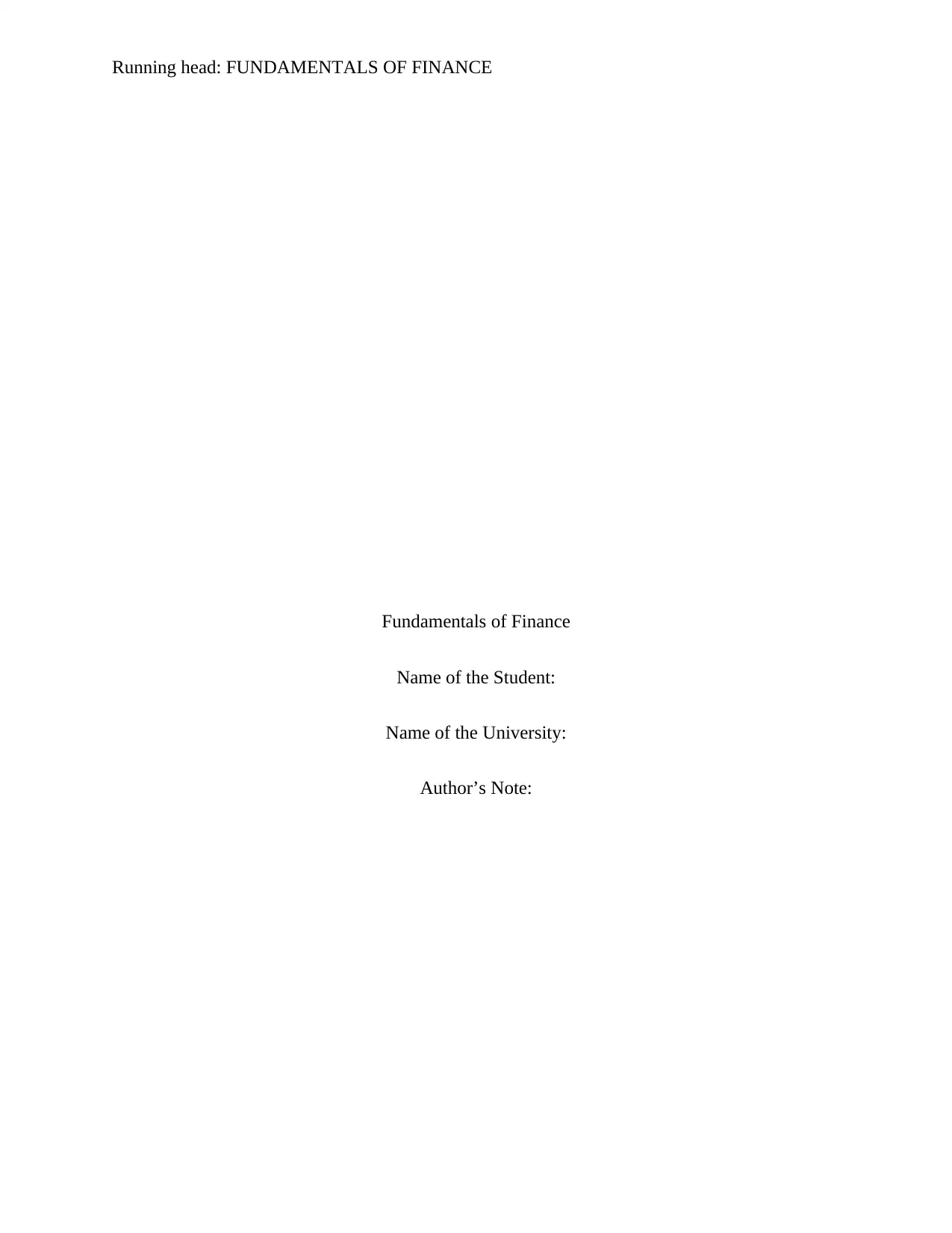
Running head: FUNDAMENTALS OF FINANCE
Fundamentals of Finance
Name of the Student:
Name of the University:
Author’s Note:
Fundamentals of Finance
Name of the Student:
Name of the University:
Author’s Note:
Paraphrase This Document
Need a fresh take? Get an instant paraphrase of this document with our AI Paraphraser
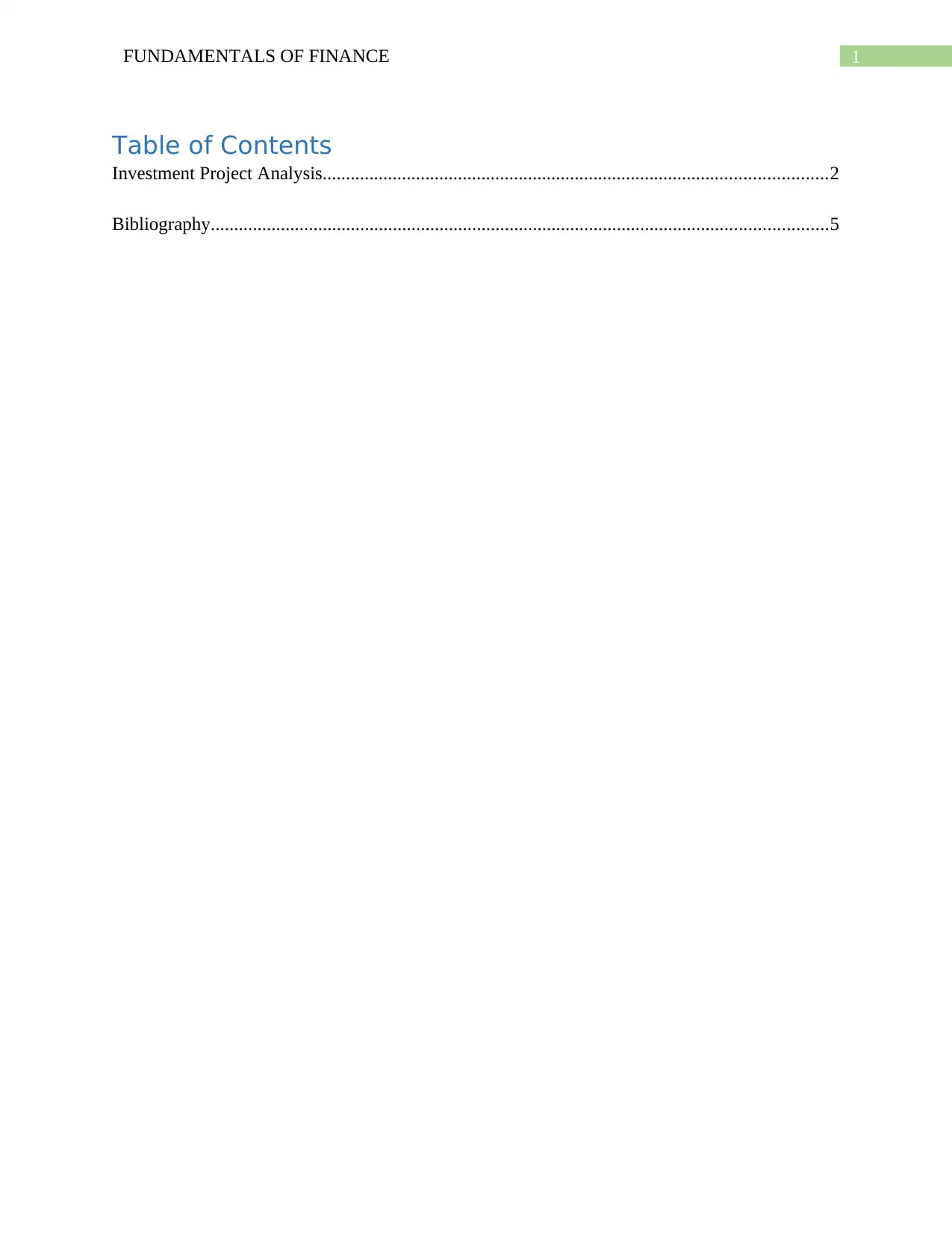
1FUNDAMENTALS OF FINANCE
Table of Contents
Investment Project Analysis............................................................................................................2
Bibliography....................................................................................................................................5
Table of Contents
Investment Project Analysis............................................................................................................2
Bibliography....................................................................................................................................5
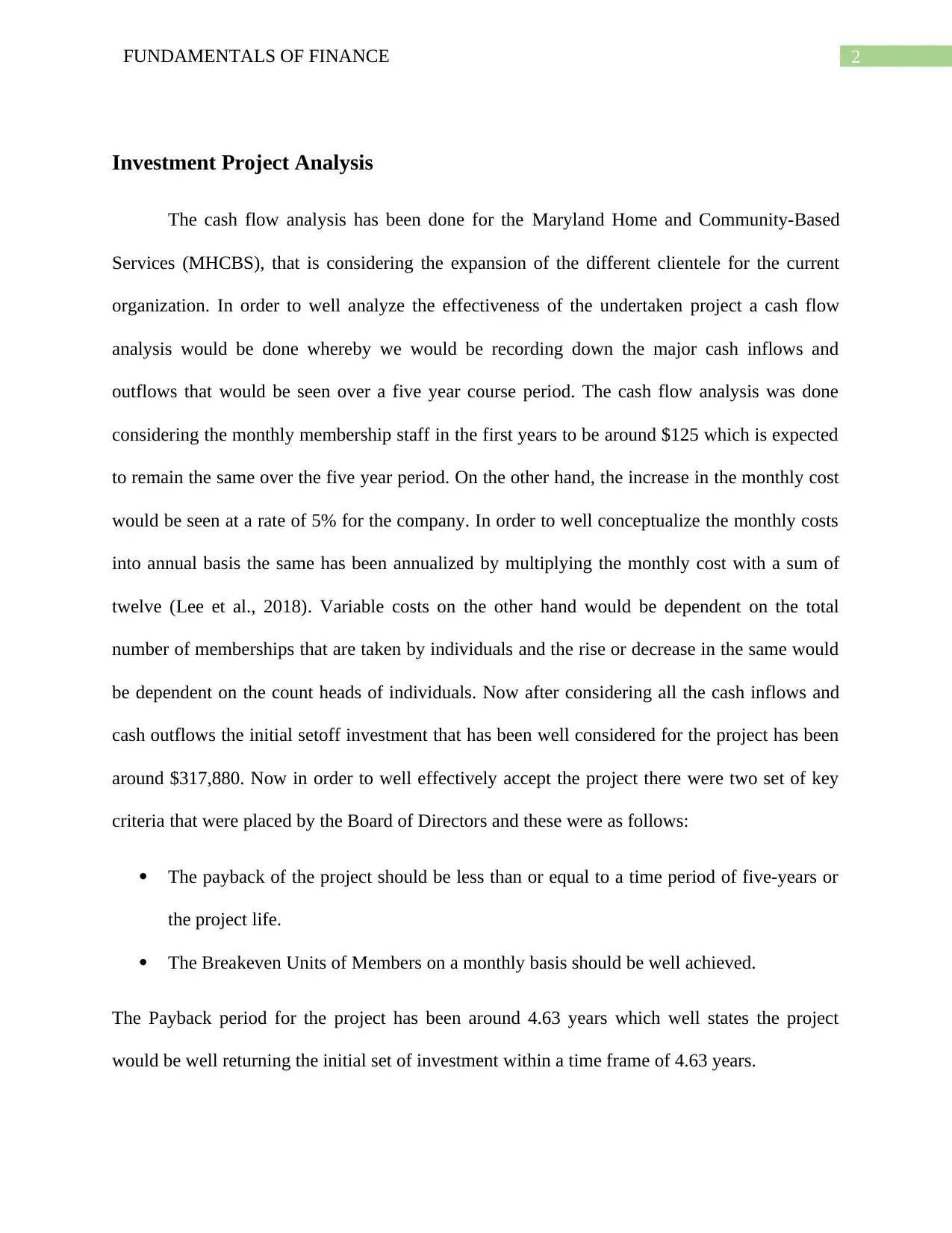
2FUNDAMENTALS OF FINANCE
Investment Project Analysis
The cash flow analysis has been done for the Maryland Home and Community-Based
Services (MHCBS), that is considering the expansion of the different clientele for the current
organization. In order to well analyze the effectiveness of the undertaken project a cash flow
analysis would be done whereby we would be recording down the major cash inflows and
outflows that would be seen over a five year course period. The cash flow analysis was done
considering the monthly membership staff in the first years to be around $125 which is expected
to remain the same over the five year period. On the other hand, the increase in the monthly cost
would be seen at a rate of 5% for the company. In order to well conceptualize the monthly costs
into annual basis the same has been annualized by multiplying the monthly cost with a sum of
twelve (Lee et al., 2018). Variable costs on the other hand would be dependent on the total
number of memberships that are taken by individuals and the rise or decrease in the same would
be dependent on the count heads of individuals. Now after considering all the cash inflows and
cash outflows the initial setoff investment that has been well considered for the project has been
around $317,880. Now in order to well effectively accept the project there were two set of key
criteria that were placed by the Board of Directors and these were as follows:
The payback of the project should be less than or equal to a time period of five-years or
the project life.
The Breakeven Units of Members on a monthly basis should be well achieved.
The Payback period for the project has been around 4.63 years which well states the project
would be well returning the initial set of investment within a time frame of 4.63 years.
Investment Project Analysis
The cash flow analysis has been done for the Maryland Home and Community-Based
Services (MHCBS), that is considering the expansion of the different clientele for the current
organization. In order to well analyze the effectiveness of the undertaken project a cash flow
analysis would be done whereby we would be recording down the major cash inflows and
outflows that would be seen over a five year course period. The cash flow analysis was done
considering the monthly membership staff in the first years to be around $125 which is expected
to remain the same over the five year period. On the other hand, the increase in the monthly cost
would be seen at a rate of 5% for the company. In order to well conceptualize the monthly costs
into annual basis the same has been annualized by multiplying the monthly cost with a sum of
twelve (Lee et al., 2018). Variable costs on the other hand would be dependent on the total
number of memberships that are taken by individuals and the rise or decrease in the same would
be dependent on the count heads of individuals. Now after considering all the cash inflows and
cash outflows the initial setoff investment that has been well considered for the project has been
around $317,880. Now in order to well effectively accept the project there were two set of key
criteria that were placed by the Board of Directors and these were as follows:
The payback of the project should be less than or equal to a time period of five-years or
the project life.
The Breakeven Units of Members on a monthly basis should be well achieved.
The Payback period for the project has been around 4.63 years which well states the project
would be well returning the initial set of investment within a time frame of 4.63 years.
⊘ This is a preview!⊘
Do you want full access?
Subscribe today to unlock all pages.

Trusted by 1+ million students worldwide
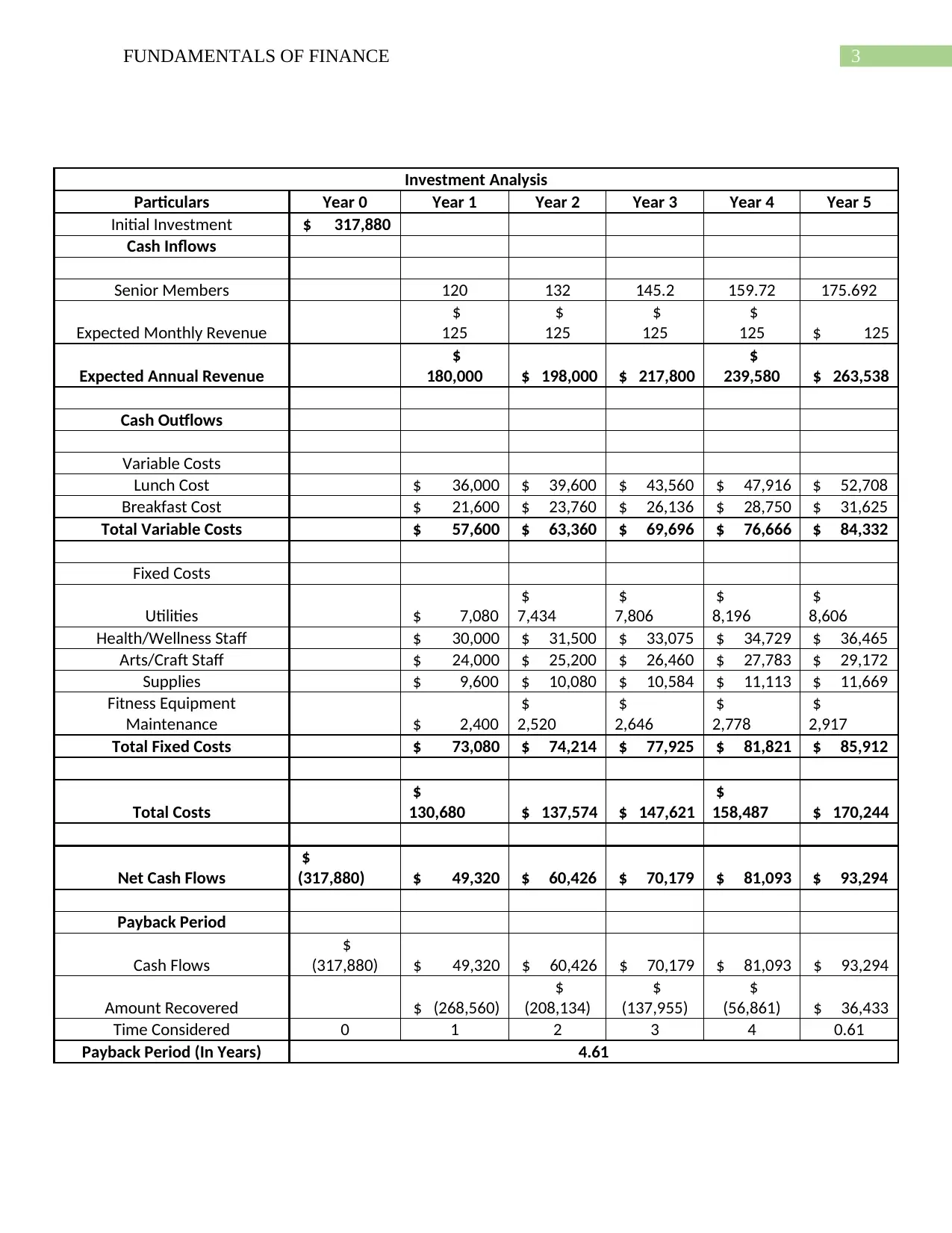
3FUNDAMENTALS OF FINANCE
Investment Analysis
Particulars Year 0 Year 1 Year 2 Year 3 Year 4 Year 5
Initial Investment $ 317,880
Cash Inflows
Senior Members 120 132 145.2 159.72 175.692
Expected Monthly Revenue
$
125
$
125
$
125
$
125 $ 125
Expected Annual Revenue
$
180,000 $ 198,000 $ 217,800
$
239,580 $ 263,538
Cash Outflows
Variable Costs
Lunch Cost $ 36,000 $ 39,600 $ 43,560 $ 47,916 $ 52,708
Breakfast Cost $ 21,600 $ 23,760 $ 26,136 $ 28,750 $ 31,625
Total Variable Costs $ 57,600 $ 63,360 $ 69,696 $ 76,666 $ 84,332
Fixed Costs
Utilities $ 7,080
$
7,434
$
7,806
$
8,196
$
8,606
Health/Wellness Staff $ 30,000 $ 31,500 $ 33,075 $ 34,729 $ 36,465
Arts/Craft Staff $ 24,000 $ 25,200 $ 26,460 $ 27,783 $ 29,172
Supplies $ 9,600 $ 10,080 $ 10,584 $ 11,113 $ 11,669
Fitness Equipment
Maintenance $ 2,400
$
2,520
$
2,646
$
2,778
$
2,917
Total Fixed Costs $ 73,080 $ 74,214 $ 77,925 $ 81,821 $ 85,912
Total Costs
$
130,680 $ 137,574 $ 147,621
$
158,487 $ 170,244
Net Cash Flows
$
(317,880) $ 49,320 $ 60,426 $ 70,179 $ 81,093 $ 93,294
Payback Period
Cash Flows
$
(317,880) $ 49,320 $ 60,426 $ 70,179 $ 81,093 $ 93,294
Amount Recovered $ (268,560)
$
(208,134)
$
(137,955)
$
(56,861) $ 36,433
Time Considered 0 1 2 3 4 0.61
Payback Period (In Years) 4.61
Investment Analysis
Particulars Year 0 Year 1 Year 2 Year 3 Year 4 Year 5
Initial Investment $ 317,880
Cash Inflows
Senior Members 120 132 145.2 159.72 175.692
Expected Monthly Revenue
$
125
$
125
$
125
$
125 $ 125
Expected Annual Revenue
$
180,000 $ 198,000 $ 217,800
$
239,580 $ 263,538
Cash Outflows
Variable Costs
Lunch Cost $ 36,000 $ 39,600 $ 43,560 $ 47,916 $ 52,708
Breakfast Cost $ 21,600 $ 23,760 $ 26,136 $ 28,750 $ 31,625
Total Variable Costs $ 57,600 $ 63,360 $ 69,696 $ 76,666 $ 84,332
Fixed Costs
Utilities $ 7,080
$
7,434
$
7,806
$
8,196
$
8,606
Health/Wellness Staff $ 30,000 $ 31,500 $ 33,075 $ 34,729 $ 36,465
Arts/Craft Staff $ 24,000 $ 25,200 $ 26,460 $ 27,783 $ 29,172
Supplies $ 9,600 $ 10,080 $ 10,584 $ 11,113 $ 11,669
Fitness Equipment
Maintenance $ 2,400
$
2,520
$
2,646
$
2,778
$
2,917
Total Fixed Costs $ 73,080 $ 74,214 $ 77,925 $ 81,821 $ 85,912
Total Costs
$
130,680 $ 137,574 $ 147,621
$
158,487 $ 170,244
Net Cash Flows
$
(317,880) $ 49,320 $ 60,426 $ 70,179 $ 81,093 $ 93,294
Payback Period
Cash Flows
$
(317,880) $ 49,320 $ 60,426 $ 70,179 $ 81,093 $ 93,294
Amount Recovered $ (268,560)
$
(208,134)
$
(137,955)
$
(56,861) $ 36,433
Time Considered 0 1 2 3 4 0.61
Payback Period (In Years) 4.61
Paraphrase This Document
Need a fresh take? Get an instant paraphrase of this document with our AI Paraphraser
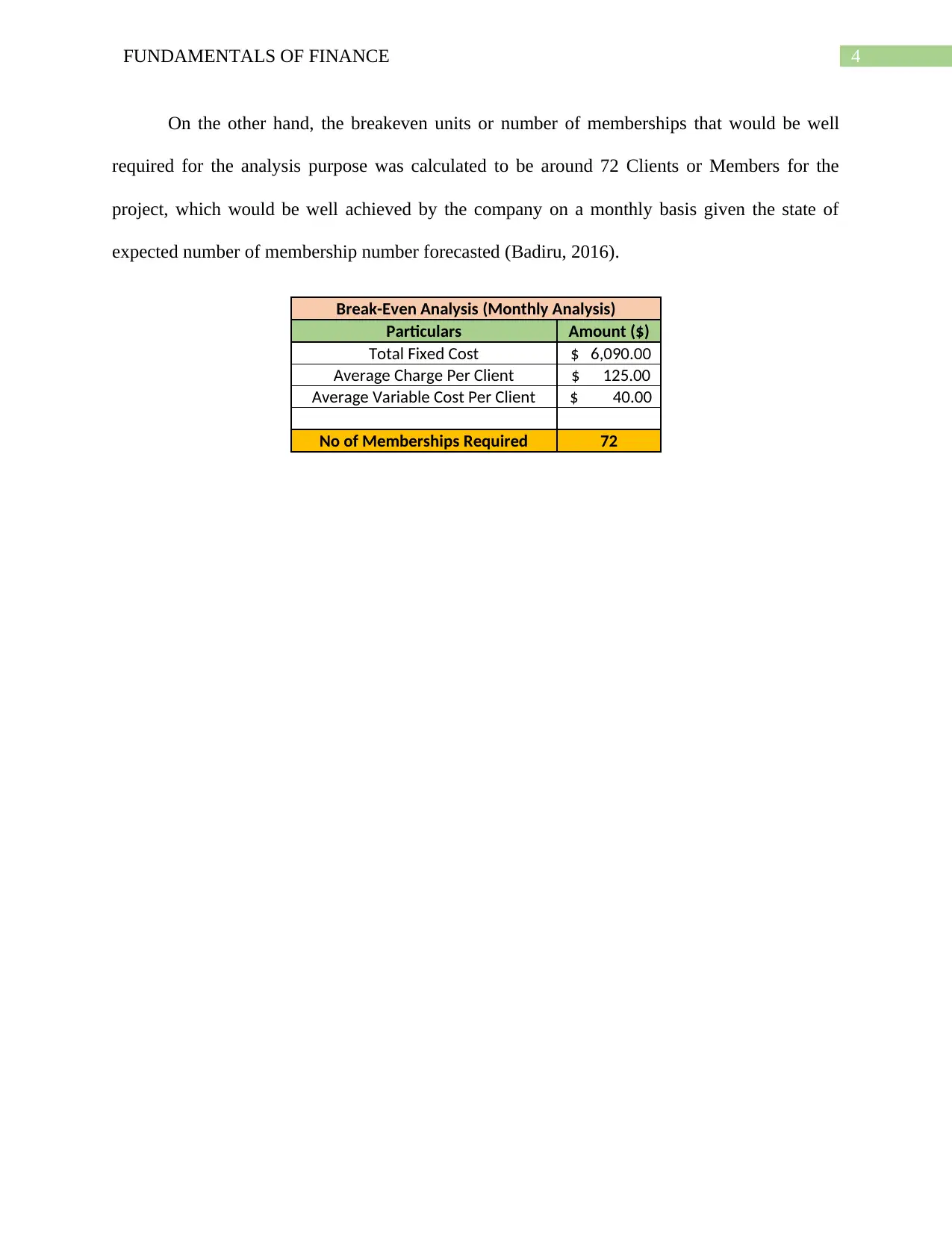
4FUNDAMENTALS OF FINANCE
On the other hand, the breakeven units or number of memberships that would be well
required for the analysis purpose was calculated to be around 72 Clients or Members for the
project, which would be well achieved by the company on a monthly basis given the state of
expected number of membership number forecasted (Badiru, 2016).
Break-Even Analysis (Monthly Analysis)
Particulars Amount ($)
Total Fixed Cost $ 6,090.00
Average Charge Per Client $ 125.00
Average Variable Cost Per Client $ 40.00
No of Memberships Required 72
On the other hand, the breakeven units or number of memberships that would be well
required for the analysis purpose was calculated to be around 72 Clients or Members for the
project, which would be well achieved by the company on a monthly basis given the state of
expected number of membership number forecasted (Badiru, 2016).
Break-Even Analysis (Monthly Analysis)
Particulars Amount ($)
Total Fixed Cost $ 6,090.00
Average Charge Per Client $ 125.00
Average Variable Cost Per Client $ 40.00
No of Memberships Required 72
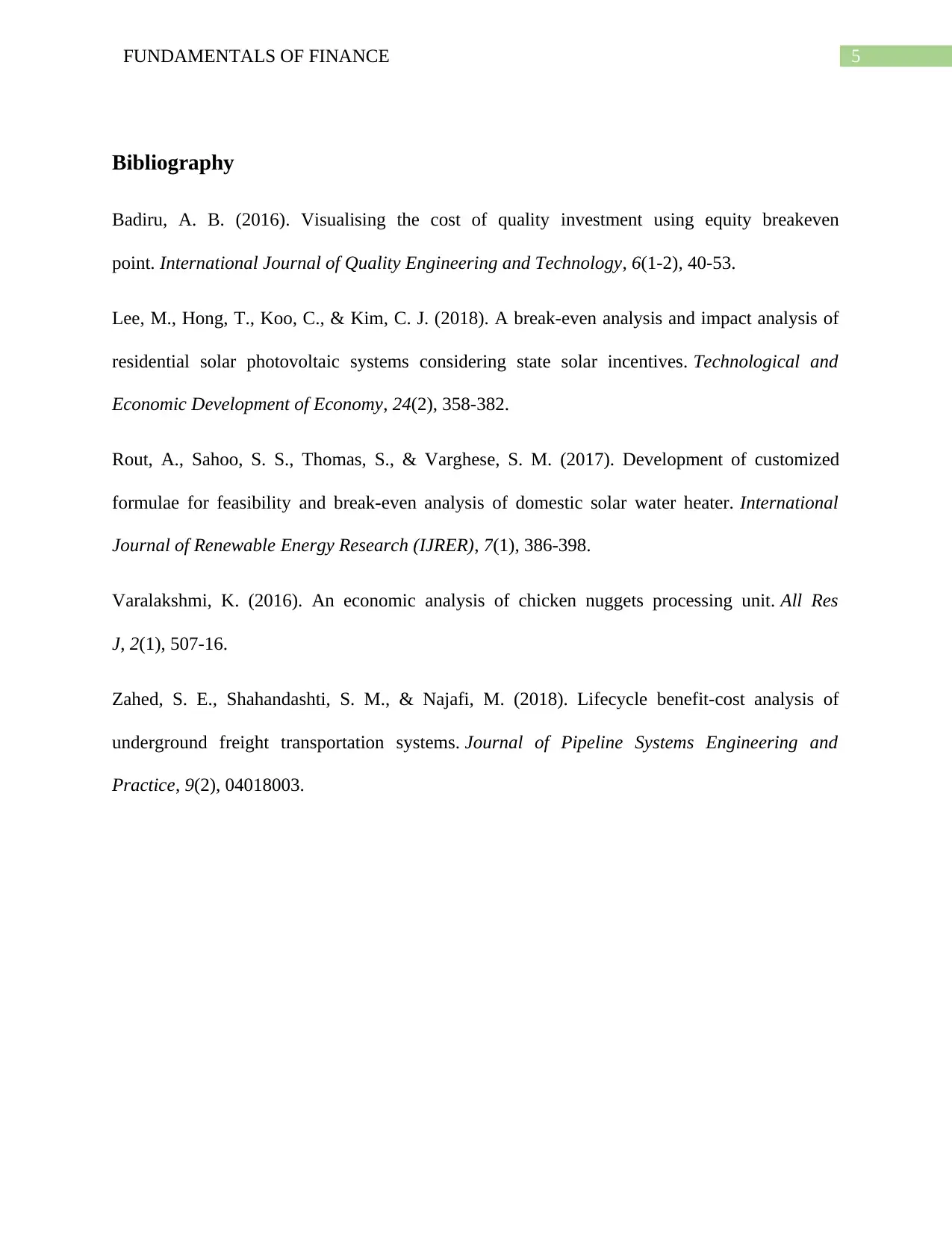
5FUNDAMENTALS OF FINANCE
Bibliography
Badiru, A. B. (2016). Visualising the cost of quality investment using equity breakeven
point. International Journal of Quality Engineering and Technology, 6(1-2), 40-53.
Lee, M., Hong, T., Koo, C., & Kim, C. J. (2018). A break-even analysis and impact analysis of
residential solar photovoltaic systems considering state solar incentives. Technological and
Economic Development of Economy, 24(2), 358-382.
Rout, A., Sahoo, S. S., Thomas, S., & Varghese, S. M. (2017). Development of customized
formulae for feasibility and break-even analysis of domestic solar water heater. International
Journal of Renewable Energy Research (IJRER), 7(1), 386-398.
Varalakshmi, K. (2016). An economic analysis of chicken nuggets processing unit. All Res
J, 2(1), 507-16.
Zahed, S. E., Shahandashti, S. M., & Najafi, M. (2018). Lifecycle benefit-cost analysis of
underground freight transportation systems. Journal of Pipeline Systems Engineering and
Practice, 9(2), 04018003.
Bibliography
Badiru, A. B. (2016). Visualising the cost of quality investment using equity breakeven
point. International Journal of Quality Engineering and Technology, 6(1-2), 40-53.
Lee, M., Hong, T., Koo, C., & Kim, C. J. (2018). A break-even analysis and impact analysis of
residential solar photovoltaic systems considering state solar incentives. Technological and
Economic Development of Economy, 24(2), 358-382.
Rout, A., Sahoo, S. S., Thomas, S., & Varghese, S. M. (2017). Development of customized
formulae for feasibility and break-even analysis of domestic solar water heater. International
Journal of Renewable Energy Research (IJRER), 7(1), 386-398.
Varalakshmi, K. (2016). An economic analysis of chicken nuggets processing unit. All Res
J, 2(1), 507-16.
Zahed, S. E., Shahandashti, S. M., & Najafi, M. (2018). Lifecycle benefit-cost analysis of
underground freight transportation systems. Journal of Pipeline Systems Engineering and
Practice, 9(2), 04018003.
⊘ This is a preview!⊘
Do you want full access?
Subscribe today to unlock all pages.

Trusted by 1+ million students worldwide
1 out of 6
Related Documents
Your All-in-One AI-Powered Toolkit for Academic Success.
+13062052269
info@desklib.com
Available 24*7 on WhatsApp / Email
![[object Object]](/_next/static/media/star-bottom.7253800d.svg)
Unlock your academic potential
Copyright © 2020–2025 A2Z Services. All Rights Reserved. Developed and managed by ZUCOL.





